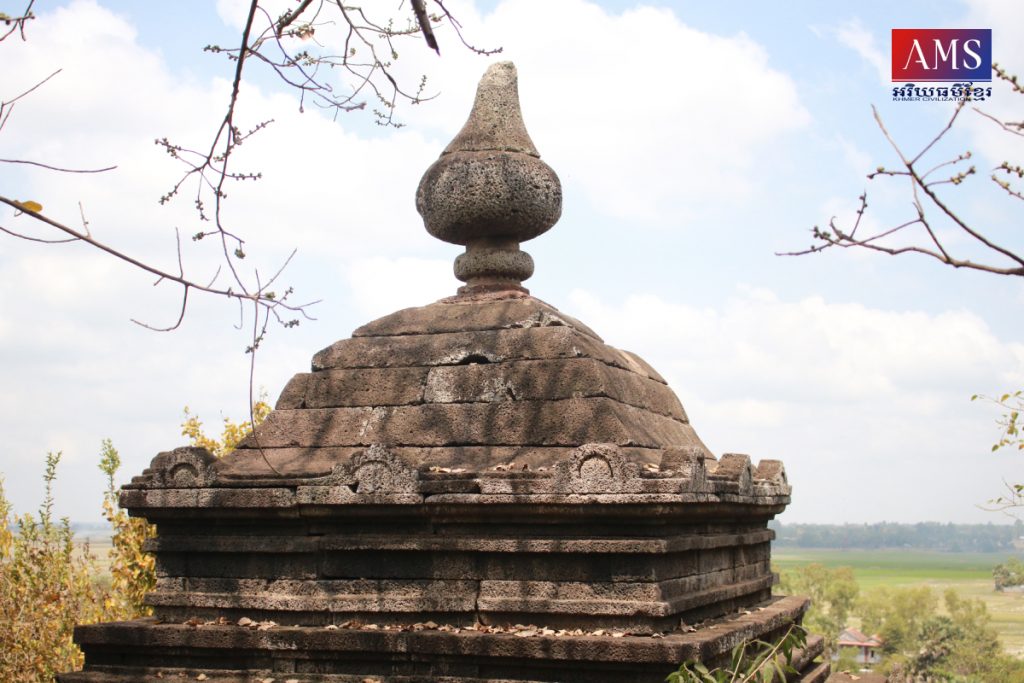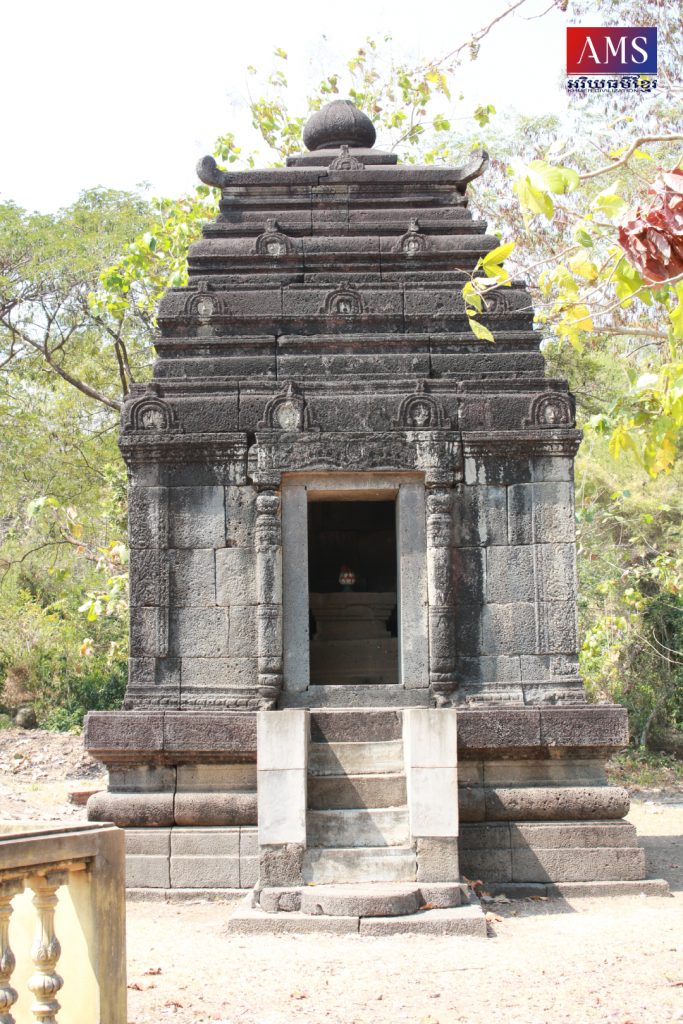អ្នកប្រាជ្ញ និងអ្នកស្រាវជ្រាវអំពីអាស៊ីអាគ្នេយ៍មួយចំនួនយល់ស្របគ្នាថាអង្គរបុរីជារាជធានីរបស់អាណាចក្រហ្វូណន។ នៅស្ថានីយអង្គរបុរី ពុំមានសេសសល់សំណង់ស្ថាបត្យកម្មច្រើននោះទេ ពោលភាគច្រើននៅសល់តែគ្រឹះប្រាសាទចាស់ៗប៉ុណ្ណោះ។ ទោះបីជាយ៉ាងណាក៏មានប្រាសាទចំនួនពីរដែលនៅរូបរាងល្អប្រសើរ ពោលគឺប្រាសាទភ្នំដា និងប្រាសាទអាស្រមមហាឥសី។ ក្រៅពីនេះក៏មានសិល្បៈលុងភ្នំមួយចំនួននៅចង្កេះភ្នំ ដែលជាប្រភេទសំណង់ស្ថាបត្យកម្មដំបូងនៅស្រុកខ្មែរដែលមានឥទ្ធិពលពីឥណ្ឌា។
ប្រាសាទអាស្រម មានទីតាំងស្ថិតនៅភូមិព្រែកតាផូ ឃុំគោកធ្លក ស្រុកអង្គរបុរី ខេត្តតាកែវ មានចម្ងាយប្រមាណ ១០០គ.ម.ពីរាជធានីភ្នំពេញ។ យើងអាចធ្វើដំណើរទៅប្រាសាទនេះតាមរយៈផ្លូវគោកក៏បាន និងផ្លូវទឹកក៏បាន (ព្រែកជីកពីទីរួមខេត្តតាកែវមកកាន់អង្គរបុរី)។ ប្រាសាទអាស្រមមហាឥសី ជាប្រាសាទតូចមួយដែលសាងឡើងអំពីថ្មពពុះ ឬថ្មបាសាល់ មានរាងបួនជ្រុងស្មើ បែរមុខទៅទិសខាងជើង។ ប្រាសាទនេះគេអាចចាត់ទុកជាប្រាសាទដែលសាងឡើងនៅលើភ្នំដំបូងៗគេ ដែលបង្ហាញពីសម័យអន្តរកាលរវាងសម័យហ្វូណននិងចេនឡា ហើយមានអាយុកាលនៅចុងស.វ.ទី៦ ដើមស.វ.ទី៧ ហើយទំនងមានអាយុកាលតំណាលគ្នានឹងគ្រឹះប្រាសាទនៅលើភ្នំដាដែរ។ នៅផ្នែកក្នុងរបស់ប្រាសាទមានកូនបន្ទប់តូចមួយសម្រាប់ការដើរប្រទក្សិណជុំវិញក្នុងកិច្ចពិធីនៃព្រហ្មញ្ញសាសនាដែលគេតែងហៅថា “គភ៌គ្រឹះ”។ សំណង់គភ៌គ្រឹះនៃប្រាសាទភ្នំដាអាចជាប្រាសាទដែលមានសំណង់គភ៌គ្រឹះដំបូងគេនៅក្នុងសិល្បៈខ្មែរ។ នៅលើប្រាសាទមានការលម្អតិចតួចនៅតាមផ្នែកផ្សេងៗដូចជា ហោជាង ផ្តែរ សសរពេជ្រ គុឌុ បង្អួច និងកំពូល។ ផ្តែរទ្វារប្រាសាទនេះពុំបានឆ្លាក់ឱ្យចប់សព្វគ្រប់ឡើយ។ ប៉ុន្តែនៅផ្នែកខាងក្រោមយើងឃើញមានរំយោលផ្កាឬកម្រងមាលាដែលមានទម្រង់ជាសិល្បៈដើមរចនាបថសំបូរព្រៃគុកនាចុងស.វ.ទី៦ ដើមស.វ.ទី៧ ដូចធ្លាប់ឃើញនៅថាឡាបរិវ៉ាត់ និងនៅតំបន់សំបូរព្រៃគុកជាដើម។ កំពូលប្រាសាទអាស្រមមហាឥសីមានរាងជាផ្កាឈូកក្រពុំដែលមានទម្រង់របៀបសិល្បៈឥណ្ឌា ដែលគេស្គាល់ថា “Kalasah” និង “Amalaka”។
នៅអំឡុងទសវត្សរ៍ឆ្នាំ១៩២០ ពេលដែលលោក Henri Parmentier បានមកដល់ប្រាសាទនេះ ហើយបានឃើញផ្នែកខ្លះនៃប្រាសាទបានរលំរួចទៅហើយ។ បន្ទាប់មកទៀតលោក Henri Mauger រៀបចំជួសជុលប្រាសាទនេះឡើងវិញនៅឆ្នាំ១៩៣៥ ដោយប្រើបច្ចេកទេស Anastylosis ពោល គឺការរើថ្មប្រាសាទចេញទាំងអស់ រួចបង់លេខតាមលំដាប់លំដោយរៀបសារជាថ្មី។ អ្នកស្រាវជ្រាវមួយចំនួនយល់ថាប្រាសាទនេះតម្កល់ទេពហរិហរ ដែលមានកម្ពស់ ១៧៣ សង់ទីម៉ែត្រ និងទទឹង៦៥ សង់ទីម៉ែត្រ និងមានកម្រាស់ ២៣ សង់ទីម៉ែត្រ។ សព្វថ្ងៃរូបនេះបានតម្កល់ទុកនៅសារមន្ទីរហ្គីម៉េ (Musée Guimet) នៃប្រទេសបារាំង។ ប៉ុន្ដែ ករណីនេះយើងគួរតែយកមកពិចារណាដែរ ព្រោះប្រាសាទនេះមានកូនបន្ទប់តូចមួយនៅខាងក្នុង។ ដូច្នេះហើយ បើគិតតាមកម្ពស់របស់ព្រះហរិហរនោះ ហាក់ដូចជាមិនសមមាត្រគ្នាជាមួយកូនបន្ទប់នោះទាល់តែសោះ។
ព្រះហរិហរនេះអាចជាទេពដែលតម្កល់នៅតាមរូបភ្នំ ឬប្រាសាទឥដ្ឋចាស់ៗដែលសព្វថ្ងៃនៅសល់តែគ្រឹះតែប៉ុណ្ណោះនៅលើភ្នំដា។ ប្រការដែលគួរឱ្យពិចារណាមួយទៀតគឺ ប្រភេទថ្មដែលយកមកសាងសង់ប្រាសាទគឺជាថ្មបាសាល់ ដែលជាថ្មមួយប្រភេទមានភាពរឹងខ្លាំងខុសពីថ្មធម្មតា ហើយថ្មប្រភេទនេះទៀតក៏ពុំមាននៅក្នុងតំបន់ក្បែរៗប្រាសាទនេះដែរ។ ប្រភេទថ្មនេះគេប្រទះឃើញមាននៅរវាងខេត្តកំពង់ចាម និងខេត្តក្រចេះត្រង់ម្ដុំថ្មគ្រែតែប៉ុណ្ណោះ។ ប្រាសាទដែលសាងពីថ្មបាសាល់នេះមានតែពីរប៉ុណ្ណោះនៅក្នុងស្រុកខ្មែរ គឺប្រាសាទអាស្រមមហាឥសី ស្ថិតនៅជើងភ្នំដា ក្នុងខេត្តតាកែវ និងប្រាសាទគុកព្រះធាតុ ស្ថិតនៅចង្កេះភ្នំហាន់ជ័យ ខេត្តកំពង់ចាម។
—————————————–
Prasat Asrom Moha Eysei
The Asrom Moha Eysei is located in Prek Tapho village, Kok Thalork commune, Angkor Borey district, Takeo province, about 100 km from Phnom Penh. We can travel to this temple by road or water (Prek Chik from Takeo to Angkor Borei). The Asrom Moha Eysei is a small temple, built of basalt that faces north. This temple can be considered as the first temple built on the mountain, the late 6th century and early 7th century between Funan and Chenla period. It has the same age as the foundation of the temple on Phnom Da.
Inside the temple, there is a small room for worshiping around the rites of Hinduism, often called the “Garbhagriha”. The Garbhagriha of Phnom Da may have been the first Garbhagriha in Khmer art. There is little decoration in various parts such as the pediment, lintel, pillars, Kudu, on the windows, and top of the temple. The lintel was not completely carved. But at the bottom, we see tassels of flowers or garlands in the original art form of the Sambor Prei Kuk style in the late 6th and early 7th centuries, as seen in Thala Borivath and in the Sambor Prei Kuk etc. The top of the Asrom Moha Eysei has shaped like a lotus flower, which has Indian art forms known as “Kalasah” and “Amalaka”
During the 1920s, Henri Parmentier arrived at this temple, he saw that parts of the temple had already collapsed. Henri Mauger then renovated the temple in 1935 using Anastylosis Techniques, dismantling all the stones and reassembling them. Some researchers concluded that the temple upheld the Harihara statue 173 cm high, 65 cm wide, and 23 cm thick. Today this Harihara is upheld in the Musée Guimet in France. But in this case, we should also consider, because this temple has a small room inside. Therefore, considering the height of Harihar, it does not seem to be in proportion to the room at all. This Harihar can be a deity upheld in caves or old brick shrines, which today only remain the foundation of the temple on Phnom Da. Another thing to consider is that the type of stone used to build the temple is basalt, which is a kind of rock that is very hard than ordinary stone, and this type of stone is not found in the area near the temple. This type of rock is found between Kampong Cham and Kratie provinces only around the Thomar Krea village. There are only two temples built of basalt in Cambodia namely the Ashram Maha Eisi temple at the base of Phnom Da in Takeo Province and the Kuk Preah Theat Temple at the base of Han Chey Mountain, Kampong Cham Province.
អត្ថបទដើម៖ លោក ម៉ង់ វ៉ាលី










